 Last additions - Nagahama 長浜市 Last additions - Nagahama 長浜市 |

May 06, 2009
|
|

Chawan Matsuri Hana-yakko flower umbrella dancers. They wear a Nagajuban kimono slip (長襦袢) and straw sandals. 花奴May 06, 2009
|
|

At 11 am, the Chigo-no-Mai dances began. The Chigo-no-Mai consisted of five dances starting with the Miko-no-Mai (Sacred Child Dance). 稚児の舞 神子の舞May 06, 2009
|
|

May 06, 2009
|
|

Only nine people know how to create these fantastic balancing decorations. They purify themselves in Takatoki River (bathe naked) before taking 3 months to make the lofty decorations in total secrecy. This is the Nihozan float (丹宝山). May 06, 2009
|
|

Juni-no-yaku musicians are from the medieval period of Japan, and rarely seen in other festivals. In Shiga, this is the only festival where they appear.May 06, 2009
|
|

I was looking forward to seeing this festival held for the first time in six years on May 4, 2009. I was not disappointed. There were many photo ops. The shrine and festival site was amid lots of greenery.May 06, 2009
|
|

The floats are constructed without using any metal nor conventional rope. Instead of rope, they use wisteria vines kneaded together. The decorations have dolls, chawan teacups, bowls, and objects related to the story depicted.May 06, 2009
|
|
|
|

The crowd line the procession route to the Chawan Matsuri no Yakata museum a short distance away. This is at the intersection called Torii-mae (鳥居前).May 06, 2009
|
|

Chawan (tea cups and bowls) and other pottery are included in the balancing decorations which seem to defy gravity as they don't fall or collapse. May 06, 2009
|
|

The Eihozan float (永宝山) decoration depicts the famous Chushingura vendetta of the 47 masterless samurai when they attacked Kira's home to avenge their master forced to commit seppuku.May 06, 2009
|
|

There were 14 Hana-yakko dancers.May 06, 2009
|
|

The Hana-yakko part of the procession was included during the late Edo Period, designed to liven up the festival.May 06, 2009
|
|

The Shinto ceremony ended and the shrine priest and co. emerged from the shrine and headed to the stage.May 06, 2009
|
|

These were all boys dancing, and they dance while facing backward. This dancer was skilled even with the long gown in the way of his feet.May 06, 2009
|
|

Sacred Child Dance. He holds two batons and later bamboo leaves (on the floor). The juni-yaku musicians provided the music for all the dances. 稚児の舞 神子の舞May 06, 2009
|
|

Blacksmith-related materials.Feb 16, 2009
|
|

Fan said to have belonged to Ichi.Feb 16, 2009
|
|

Map of the Battle of Anegawa where Lord Azai Nagamasa fought against Tokugawa Ieyasu and Oda Nobunaga in 1570.Feb 16, 2009
|
|

Photo of an unusual ax.Feb 16, 2009
|
|

Relics from Odani CastleFeb 16, 2009
|
|

Model of Odani Castle on a mountaintop.Feb 16, 2009
|
|

More exhibits about local history.Feb 16, 2009
|
|

Ichi or Oichi, wife of Azai Nagamasa.Feb 16, 2009
|
|

Portrait panels of Nagamasa, Ichi, and their three daughters.Feb 16, 2009
|
|

Second floor of the museum with a fake stone castle gate.Feb 16, 2009
|
|

Lord Azai Nagamasa Feb 16, 2009
|
|

Feb 16, 2009
|
|

Feb 16, 2009
|
|

This folding panel greets you with a portrait of Lord Azai Nagamasa and wife Ichi.Feb 16, 2009
|
|

Near the entrance was the wooden bath.Feb 16, 2009
|
|

Wooden bathtubFeb 16, 2009
|
|

Feb 16, 2009
|
|

Food for Okonai Festival.Feb 16, 2009
|
|

How they bathed in the bathtub.Feb 16, 2009
|
|

Kitchen.Feb 16, 2009
|
|

Feast for Okonai Festival.Feb 16, 2009
|
|

Biwa stringsFeb 16, 2009
|
|

When I visited in Feb. 2009, there was an exhibit showing artifacts of a local Okonai Festival (held in various locations during Jan. to March to pray for a good harvest).Feb 16, 2009
|
|

Inside Shichirinkan, a former blacksmith's house from the 19th century. 七りん館Feb 16, 2009
|
|

Biwa luteFeb 16, 2009
|
|

Products which use silk threads made in Azai. They were mainly used for the strings of string instruments such as the koto, samisen, and biwa lute.Feb 16, 2009
|
|

Silk cocoons.Feb 16, 2009
|
|

Koto strings made of Azai silk threads. Numerous silk threads are twisted together to make a koto string.Feb 16, 2009
|
|

Room with a hearth.Feb 16, 2009
|
|

Large exhibition rooms.Feb 16, 2009
|
|

Model of silkworm racks.Feb 16, 2009
|
|

A mannequin spinning silk thread.Feb 16, 2009
|
|

Feb 16, 2009
|
|

The Azai Folk History Museum (Azai Rekishi Minzoku Shiryokan) has two large thatched-roof houses. This one is called Itohime no Yakata which shows Azai's silk production history. 糸姫の館 MAPFeb 16, 2009
|
|

Feb 16, 2009
|
|

Oichi-no-Sato includes Azai Public Library on the left. Its entrance looks like a castle gate. Address: Oyoricho 528, Nagahama. 大依町 Phone: 0749-74-0101 浅井図書館Feb 16, 2009
|
|

Map of Oichi-no-Sato. The biggest building on the left is the Azai Public Library. If you don't have a car, catch the Kokoku Bus (Takayama Route) at Nagahama Station and get off at Plaza Fukura no Mori-mae (プラザふくらの森前). Walk 10 min. Feb 16, 2009
|
|

Oichi or Ichi (1547–1583) gave birth to three daughters who associated with famous men. They were Chacha (Toyotomi Hideyoshi's concubine), Hatsu (married Kyogoku Takatsugu), and Ogo (married Tokugawa Hidetada).Feb 16, 2009
|
|

Sign for Oichi-no-Sato, a complex consisting of a public library and folk history museums. Named after Ichi, the wife of Lord Azai Nagamasa who resided at Odani Castle. She was also the younger sister of warlord Oda Nobunaga.Feb 16, 2009
|
|

Connected via a passageway to the Kohoku Wildbird Center is the Biwako Waterfowl and Wetland Center set up by the Ministry of the Environment in 1997. It is also operated by Kohoku town.Feb 15, 2009
|
|

Autographs of various prominent people who visited the Kohoku Wild Bird Center.Feb 15, 2009
|
|

Actual-size cutout of Steller's sea eagle. The center has two telescopes aimed at the bird for a clear view. It is a very large bird with a wingspan of over 2 meters. You need a very large telephoto lens to photograph the bird on the mountain.オオワシFeb 15, 2009
|
|

Viewing room in the Biwako Waterfowl and Wetland Center.Feb 15, 2009
|
|

Migratory patterns in the Kohoku area.Feb 15, 2009
|
|

On the opposite side of the center is Mt. Yamamoto-yama. On this day in Feb., we saw the Steller's sea eagle perched on a tree on this mountain.Feb 15, 2009
|
|

On this day in Feb., I saw ducks and gray heron (ao-sagi).Feb 15, 2009
|
|

Explanation of Steller's sea eagle and its movement in the area.Feb 15, 2009
|
|

The Kohoku Wild Bird Center is well equipped for bird-watching and also features exhibits of stuffed birds.Feb 15, 2009
|
|

DucksFeb 15, 2009
|
|

Bulletin board indicating the bird species observed that day and where they were seen in the area. The center keeps track of bird locations in Lake Biwa, Hayasaki Naiko Biotope, and Mt. Yamamoto-yama.Feb 15, 2009
|
|

Kohoku Wild Bird Center, admission 200 yen. This center was established by Shiga Prefecture in Nov. 1988 and it is operated by Kohoku town. 湖北野鳥センターFeb 15, 2009
|
|

Display of various bird nests.Feb 15, 2009
|
|

The birds rest on a small island close to the shore.Feb 15, 2009
|
|

View from the Kohoku Wild Bird Center. Feb 15, 2009
|
|

Inside Kohoku Wild Bird Center. It has large picture windows facing Lake Biwa and high-powered binoculars enabling you to clearly see the waterfowl. 湖北野鳥センターFeb 15, 2009
|
|

Map of Kohoku-cho Waterfowl Park that includes a bird-watching center called Kohoku Wild Bird Center and the Biwako Waterfowl and Wetland Center. Feb 15, 2009
|
|

Sign welcoming you to the Kohoku Town Waterfowl Park along the northeastern shore of Lake Biwa, directly north of Nagahama. MAPThis is slightly north of Hayasaki Biotope.Feb 15, 2009
|
|
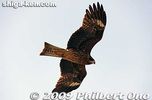
Meanwhile above, a black kite soars above looking for fish. The bird is a common site at Lake Biwa.Feb 15, 2009
|
|

Ducks seek the protection of the reeds.Feb 15, 2009
|
|

Reeds and Mt. IbukiFeb 15, 2009
|
|

Looks like a prime place for fish and birds to dwell.Feb 15, 2009
|
|
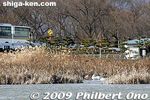
Migratory birds in Feb.Feb 15, 2009
|
|

For demonstrative purposes, an arrow-shaped "eri" fish trap was recently built in the biotope. It is similar to the ones found in Lake Biwa. It leads fish swimming along the fence into a small area where they can be caught.Feb 15, 2009
|
|

Feb 15, 2009
|
|

This is where kids can play in the water and catch fish, etc. After observing and identifying the fish, prawns, etc., the kids return the fish back into the water. Fishing is prohibited here.Feb 15, 2009
|
|

At the end of the arrow tip is where the fish eventually gather so fisherman can just scoop up the fish. The fish don't backtrack and so they don't escape this place.Feb 15, 2009
|
|

In winter, migratory birds come to Hayasaki Naiko Biotope.Feb 15, 2009
|
|

Where there are reeds, there is life. Feb 15, 2009
|
|

Mt. Ibuki Feb 15, 2009
|
|

Reeds oin a flooded part of the Hayasaki Naiko Biotope.Feb 15, 2009
|
|

This area seen here has been flooded with water as part of the biotope. Reed beds now flourish. Mt. Ibuki is in the background. These pictures were taken in Feb.Feb 15, 2009
|
|

Sign explaining about Hayasaki (Hayazaki) Naiko Biotope. It was an attached lake to Lake Biwa until it was filled in as reclaimed land in 1970.Feb 15, 2009
|
|

In Nov. 2001, part of the land was flooded with water as an experiment, and the ensuing plant and wildlife were observed. MAPFeb 15, 2009
|
|

A number of attached lakes in Shiga were reclaimed to make rice paddies amid a shortage of food after the war. This has proven to be detrimental to Lake Biwa's ecology, and now Shiga wants to restore Hayasaki's reclaimed land back to an attachedFeb 15, 2009
|
|

Famous Japanese garden outside the shoin 文部省指定の名勝庭園Aug 24, 2008
|
|

This statue is a large replica of the actual Jizo statue worshipped in the temple. 地蔵大銅像Aug 24, 2008
|
|

Former bank building called Koyukan, now used for flea markets and other events. 交遊館Aug 24, 2008
|
|

Hokkoku Kaido RoadAug 24, 2008
|
|

Hokkoku Kaido RoadAug 24, 2008
|
|

On Hokkoku Kaido Road fronting the temple, more food/game stalls.Aug 24, 2008
|
|

Jizo statueAug 24, 2008
|
|

You can exchange the balls with prizes (more balls = better prizes).Aug 24, 2008
|
|

Kids catching small colorful balls in the water with a paper net.Aug 24, 2008
|
|

Votive prayer tablets with frog design.Aug 24, 2008
|
|

Giant Jizo statue overlooks food stalls within the temple grounds.Aug 24, 2008
|
|

Worshippers inside the Kinomoto Jizo-in temple. Scroll down further to see what it looks like without all the people.Aug 24, 2008
|
|

Lighting incense.Aug 24, 2008
|
|

View from the temple.Aug 24, 2008
|
|

What Jizo-zaka looks like from the Jizo-in temple entrance.Aug 24, 2008
|
|

During the annual Kinomoto Jizo Festival, an endless stream of people come to worship.Aug 24, 2008
|
|

Kinomoto Jizo-in temple during the Kinomoto Jizo Festival held Aug. 22-25. MAPAug 24, 2008
|
|

Going to worship at Kinomoto Jizo-in temple.Aug 24, 2008
|
|

Jizo-zaka road as seen from the temple.Aug 24, 2008
|
|

Jizo-zaka road. Ennichi is the temple or shrine's auspicious or special commemoration days. When you go to worship on such days, your prayers will be answered in better ways than usual. The festival is held from 9 am to 10 pm. 地蔵坂Aug 24, 2008
|
|

Jizo-zaka as seen from Jizo-in temple. On the last day of the festival (Aug. 25)., fireworks is held from 8 pm to 8:30 pm.Aug 24, 2008
|
|

Near Kinomoto Station is Jizo-zaka road, a slightly sloping cobblestone road leading to the Jizo-in temple. During the annual Kinomoto Jizo Ennichi Festival held on Aug. 22-25, this road is packed with food stalls and people going to worship. 地蔵縁日Aug 24, 2008
|
|

View of Mt. Toragozen-yama from the Hokuriku Line train. Cherry blossoms on the mountain.Aug 23, 2008
|
|

Rice paddies next to Okaido.Jul 07, 2008
|
|

Amenomori Hoshu monument (not grave). Hoshu is buried in Tsushima, Nagasaki.Jul 07, 2008
|
|

To mark the site, Okaido has a small park where two sample Yayoi-Period structures stand. This adobe is pretty much a hole in the ground with a thatched roof over it.Jul 07, 2008
|
|

Jul 07, 2008
|
|

Slightly north of Amenomori is Okaido, a site where the ruins of numerous Yayoi-Period homes and canals and artifacts were found. 15-min. by taxi from Takatsuki Station. 大海道遺跡 MAPJul 07, 2008
|
|

Jul 07, 2008
|
|

Tea ceremony room.Jul 07, 2008
|
|

Faces of Hoshu on the wall.Jul 07, 2008
|
|

Japanese garden at Amenomori Hoshu-an museum.Jul 07, 2008
|
|

Hoshu rightly believed that language represented the culture, and learning the language was thus essential to understand the country.In 2017, Amenomori Hoshu's documents related to Japan-Korea relations during the Edo Period will be inscribed as a UNESCO Memory of the World.Jul 07, 2008
|
|

Statue of Hoshu. At age 25, Hoshu learned Chinese. At age 36, he lived and studied Korean in Pusan for 3 years during 1702-1705.Jul 07, 2008
|
|

Statue of Amenomori Hoshu. He is regarded as a pioneer in Korean-Japanese relations and an internationally-minded person ahead of his time.Jul 07, 2008
|
|

Assembly hall. The museum sometimes holds events. Once a year, they conduct a homestay program for students from South Korea.Jul 07, 2008
|
|

Route of the Korea's royal embassy procession to Edo. The Korean kingdom sent an official mission to Edo when there was a significant occasion, such as the installation of a new shogun. They traveled along this route which also passed through Shiga.Jul 07, 2008
|
|

At age 18, Hoshu went to Edo and studied Confucianism under Confucian scholar Kinoshita Jun'an. He was later employed by the Tsushima clan and was put in charge of Korean relations at age 22.Jul 07, 2008
|
|

Entry to the Amenomori Hoshu-an. It exhibits things, books, documents, etc., related to Amenomori Hoshu. Admission 250 yen. Hours: 9 am - 4 pm, closed Mon. Phone: 0749-85-5095Jul 07, 2008
|
|

This is the museum room with various exhibits related to Amenomori Hoshu and Japan-Korean relations during the Edo Period. Hoshu was based in Tsushima in Nagasaki, an island close to Korea.Jul 07, 2008
|
|

Large zelkova (keyaki) tree at the museum. Takatsuki has numerous old and distinguished trees.Jul 07, 2008
|
|

Amenomori Hoshu-an museum. Built on the land where Amenomori Hoshu's house once stood. Born in Amenomori, Amenomori Hoshu (1668-1755) was a Confucian scholar and leading diplomat to Korea during the Edo Period.Jul 07, 2008
|
|

Road in front of Amenomori Hoshu-an museum dedicated to Amenomori Hoshu (1668-1755), a Confucian scholar and leading diplomat to Korea during the Edo Period.Jul 07, 2008
|
|

Front gate to Amenomori Hoshu-an museum built in 1984. Known as the East Asia Exchange House Amenomori Hoshu-an Museum. 東アジア交流ハウス雨森芳洲庵 MAPJul 07, 2008
|
|

Amenomori is Takatsuki's showcase and flagship area. It's a quiet, rural part of town with waterwheels, roadside streams and flowers. Charming and picturesque.Jul 07, 2008
|
|

This waterwheel has become one of the symbols of this area. It's in front of the Amenomori Hoshu-an museum.Jul 07, 2008
|
|
|

One of Takatsuki's eye-catching buildings is this Yanmar Kaikan Public Hall in Higashi Atsuji. It is the birthplace of Yamaoka Magokichi, founder of Yanmar Co. ヤンマー会館 MAPJul 07, 2008
|
|

Monument marking the birthplace of Yamaoka Magokichi (1888-1962) 山岡孫吉, founder of Yanmar Diesel, Co. In 1933, he developed the world's first compact diesel engine.Jul 07, 2008
|
|

This public hall was built and donated to the town by Magokichi. It has a Gothic architecture. In 1912, at age 24, he established Yamaoka Hatsudoki Seisakusho 山岡発動機工作所, the forerunner of Yanmar Diesel Co.Jul 07, 2008
|
|
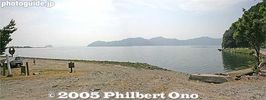
Great view of Lake Biwa after passing through Katayama Tunnel.Jul 07, 2008
|
|

Katayama Tunnel, leading to Lake Biwa. 片山トンネルJul 07, 2008
|
|

Map of TakatsukiJul 07, 2008
|
|

View after passing through Katayama Tunnel.Jul 07, 2008
|
|

Nishino Yakushido Kannon-do Hall, also called Jumanji temple. Inside this hall is one 11-face and fleshy Kannon statue and one Yakushi Nyorai statue. Photography not allowed. 充満寺Jul 07, 2008
|
|

Welcome to Yakushodo. This is one of the most noted Kannon temples in Takatsuki. The temple's 11th priest, Esho 恵荘, was the one who engineered the Nishino Water Tunnel in 1845.Jul 07, 2008
|
|

Nishino Yakushido Kannon-do Hall is in western Takatsuki. Noted for two Kannon statues which are Important Cultural Properties. 西野薬師観音堂 MAPJul 07, 2008
|
|

Strongman's Stone. If you want to see the Kannon statues at Nishino Yakushido, call 090-8938-6369 in Japanese before you go.Jul 07, 2008
|
|

This is the third water tunnel and currently in use. The Yogo River flows out of it to Lake Biwa. Built in 1980. Also a local fishing spot.Jul 07, 2008
|
|

Rice paddies near Nishino Water Tunnel.Jul 07, 2008
|
|

Original Nishino Water Tunnel facing Lake Biwa.Jul 07, 2008
|
|

Yogo River mouth outside the Nishino water tunnel. Lake Biwa ahead.Jul 07, 2008
|
|

This is the second water tunnel, next to the original tunnel and running parallel.Jul 07, 2008
|
|

Other end of the second tunnel. This tunnel is no longer used for Yogo River. It is now mainly used by people wanting to go fishing.Jul 07, 2008
|
|

Floor of second water tunnel. Some water still flows through. Boots recommended.Jul 07, 2008
|
|

Entrance to the second water tunnel. This is much larger, large enough for a car to pass through. No longer used as a water drainage tunnel. We could easily walk through this tunnel.Jul 07, 2008
|
|

This is the other end of the original tunnel. The air was cold on this end.Jul 07, 2008
|
|

This is the original Nishino Water Tunnel built in 1845. Engineered by a Buddhist priest named Esho and with the help of fellow villagers, it took 6 years to dig through the mountain for about 220 meters. The tunnel drained excess water to Lake Biwa.Jul 07, 2008
|
|

The problem is, it's pitch black on the inside, and the tunnel size is quite small and craggy. Hard hats required. Not recommended, especially if you are taller than a 10-year-old.Jul 07, 2008
|
|

You can enter and go through the Nishino Water Tunnel. Water does not flow through anymore, but it's still quite muddy and wet.Jul 07, 2008
|
|

Lyrics to the song, "Nishino Suido Uta." 西野水道歌Jul 07, 2008
|
|

Monument for a song about the tunnel digging, titled "Nishino Suido Uta."Jul 07, 2008
|
|

Tunnel monument and song monument.Jul 07, 2008
|
|

The monument shows tunnel laborers.Jul 07, 2008
|
|

Statue and monument at Nishino Water Tunnel entrance.Jul 07, 2008
|
|

Near the tunnel entrance is the Nishino Horinuki Park with various monuments. 西野ほりぬき公園Jul 07, 2008
|
|

Nishino Water Tunnel is near Lake Biwa at the foot of the Yamamoto-yama mountains. There are three tunnels. The original one was built in 1845 by a local priest to alleviate frequent flooding. 西野水道 MAPJul 07, 2008
|
|

Near the tunnel entrance is a rest house where you can borrow rubber boots and flash lights for free.Jul 07, 2008
|
|

Biwako Shokudo restaurant serves its specialty: Tall pile of vegetables in a boiling pot. びわこ食堂Jul 07, 2008
|
|

After you eat the main dish, mixing udon noodles in the miso broth is also good (if you still have room in your stomach).Jul 07, 2008
|
|

After cooking, the tall pile of vegetables (mainly Chinese cabbage) shrinks. This is for two people. Chicken and miso broth.Jul 07, 2008
|
|

One of Takatsuki's famous trees.Jul 07, 2008
|
|

Tourist map signboard in English too.Jul 07, 2008
|
|

Train tracks to Takatsuki StationJul 07, 2008
|
|

Kannon bus tour. People who visit the Kannon temples are elderly. No young people (except me) tour the Kannon temples. Tours are held during the Furusato Matsuri in early Aug. Usually sells out.Jul 07, 2008
|
|

Banner for the Furusato Matsuri held in early Aug.Jul 07, 2008
|
|

Local community bus/van at Takatsuki Station.Jul 07, 2008
|
|

The old and small Takatsuki Station in 2004. Actually, I like this station better. It makes it more rural.Jul 07, 2008
|
|

Inside tourist info office which is also a souvenir shop.Jul 07, 2008
|
|

Have a Nice Day wooden bench at the train station.Jul 07, 2008
|
|

JR Takatsuki Station corridor. Impressive new train station.Jul 07, 2008
|
|

JR Takatsuki Station on the east side.Jul 07, 2008
|
|

Tourist info and resthouse at JR Takatsuki Station on the east side. You can also rent bicycles here.Jul 07, 2008
|
|

Chrysanthymum displayJul 07, 2008
|
|

Inoue Yasushi Memorial Room recreates his room where he wrote novels. He also wrote Furinkazan, which was made into an NHK Taiga period drama in 2007. 井上靖記念室Jul 07, 2008
|
|

JR Takatsuki Station on the Hokuriku Line. West side. This new station building was built in Oct. 2005. 高月駅Jul 07, 2008
|
|

JR Takatsuki Station on the West side. 高月駅Jul 07, 2008
|
|

JR Takatsuki Station stairway on the east side.Jul 07, 2008
|
|

The public library's 2nd floor has this Inoue Yasushi Memorial Room. Inoue (1907-1991) was a famous novelist who visited Takatsuki a lot and wrote novels featuring Takatsuki's Kannon statues. 井上靖記念室Jul 07, 2008
|
|

The novel "Hoshi to Matsuri" 星と祭 mentions Kannon statues in Takatsuki and northern Shiga. In 1950, he won the Akutagawa Prize, one of Japan's most prestigious literary prizes.Jul 07, 2008
|
|

Built in 1992, Deai-no-Mori Public Library is part of a lush, green park. 10-min. walk from Takatsuki Station. Hours: 10 am - 6 pm, closed Mon., Tue., national holidays, and year end/New Year's. 出会いの森図書館 [url=http://goo.gl/maps/DW6c3]Jul 07, 2008
|
|

Inside Takatsuki Kannon Temple (Daienji temple).Jul 07, 2008
|
|

Takatsuki Kannon Temple (Daienji temple), main hall. 大円寺Jul 07, 2008
|
|

Autumn at Takatsuki Kannon TempleJul 07, 2008
|
|

Jul 07, 2008
|
|

Jul 07, 2008
|
|

Jul 07, 2008
|
|

Entrance to Takatsuki Kannon Temple (Daienji temple).Jul 07, 2008
|
|

Takatsuki Kannon Temple (Daienji temple) is also near Takatsuki Station, in the south. Temple noted for a 1000-arm Kannon statue. 大円寺 MAPJul 07, 2008
|
|

Guide to Kannon statues in Takatsuki. On the left is the National Treasure Kannon statue at Doganji temple. One of seven 11-face Kannon statues in Japan which is a National Treasure. This one is said to be the most beautiful. 十一面観音立像Jul 07, 2008
|
|

Inside Kannon Folk History Museum, which is near Doganji and 10-min. walk from Takatsuki Station. The museum opened in 1984. Admission 250 yen. Museum hours 9 am - 4:30 pm. Closed Mon., the day after national holidays, and year end/New Year's.Jul 07, 2008
|
|

Tourist map of Takatsuki which has quite a few temples with a Kannon statue.Jul 07, 2008
|
|

Kannon Folk History Museum (Kannon no Sato Rekishi Minzoku Shiryokan) has various exhibits about Kannon and the town's historical persons. 観音の里歴史民俗資料館 MAPJul 07, 2008
|
|

Kogenji Temple in Takatsuki, Nagahama belongs to the Buddhist Jodo Shinshu Sect (Otani school). On the left of this main hall is the Doganji Kannon Hall where the 11-face Kannon statue (National Treasure) can be viewed. 渡岸寺観音堂(向源寺)Jul 07, 2008
|
|

Inside Kogenji Temple main hall. Admission to see the Kannon statue is 300 yen. Open 9 am - 4 pm. Parking available. Appointment not necessary to see the Kannon statue.Jul 07, 2008
|
|

Picture taking of the Kannon statue is not allowed. The statue was carved by Taicho 泰澄 in the 8th century for Emperor Shomu. During the war between the Azai and Oda Nobunaga, the temple was burned. But the statue had been buried and was saved.Jul 07, 2008
|
|

Approach to Doganji (also called Kogenji) Temple. 10-min. walk from JR Takatsuki Station. 渡岸寺観音堂(向源寺)MAPJul 07, 2008
|
|

Jun 22, 2008
|
|

Jun 22, 2008
|
|

Jun 22, 2008
|
|

Jun 22, 2008
|
|

Plum blossoms and Nagahama Castle.Jun 22, 2008
|
|

Plum tree and Nagahama Castle.Jun 22, 2008
|
|

Plum tree grove called "bairin."Jun 22, 2008
|
|

Plum blossoms, Hokoen Park, Nagahama, ShigaJun 22, 2008
|
|

Jun 22, 2008
|
|

Jun 22, 2008
|
|

The plum blossoms are mainly red and white.Jun 22, 2008
|
|

Jun 22, 2008
|
|

Stone marker near Otabisho marking the location of the castle's Otemon Gate.Jun 22, 2008
|
|

Hokoen Park also has a good-size grove of plum blossoms which bloom in March.Jun 22, 2008
|
|

Nagahama Castle and plum blossoms.Jun 22, 2008
|
|

Jun 22, 2008
|
|

Water fountainJun 22, 2008
|
|

Stone marker in central Nagahama marking the location of the castle's Sotobori outer moat.
Jun 22, 2008
|
|

Marker indicating the location of Nagahama Castle's stone wall.Jun 22, 2008
|
|

With snow.Jun 22, 2008
|
|

Jun 22, 2008
|
|

Jun 22, 2008
|
|

Athletic field in Hokoen Park. You can see the castle tower in the distance toward the right among the trees.Jun 22, 2008
|
|
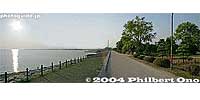
Shoreline of Hokoen Park facing Lake Biwa.Jun 22, 2008
|
|

In summer, the park has lots of green.Jun 22, 2008
|
|

Shoreline near Nagahama Castle.Jun 22, 2008
|
|

Lake Biwa shore near Nagahama Castle.Jun 22, 2008
|
|

Jun 22, 2008
|
|
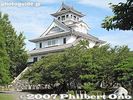
Nagahama Castle in summer.Jun 22, 2008
|
|

Jun 22, 2008
|
|

Jun 22, 2008
|
|

Rice paddy and reed bed. Restoring Hayasaki Naiko may take decades. For tours (May-Nov.) of Hayasaki biotope, call in Japanese: 0749-72-2262 (Hayasaki Biotope Networking).Jun 21, 2008
|
|

View of Hayasaki Naiko from the eastern edge. There is a committee for restoring Hayasaki Naiko, but reaching an agreement on planning and implementation takes a long time.Jun 21, 2008
|
|

Rice paddy and reed bed. Special thanks to Makino Atsushi (Lake Biwa Museum) and Kurahashi Yoshihiro (Hayasaki Biotope Networking) for the tour of Hayasaki biotope.Jun 21, 2008
|
|

What used to be a lake is a rice paddy. Imagine this to be a lake, with an embankment in front of these homes.Jun 21, 2008
|
|

Houses in Hayasaki village faced the eastern shore of Hayasaki Naiko. When the restoration is completed, this road would have to be further elevated by 1 meter or so as an embankment.Jun 21, 2008
|
|

View of Hayasaki Naiko from the eastern edge. One stumbling block to the restoration is high land prices. Shiga needs to purchase all of the reclaimed land.Jun 21, 2008
|
|

This is the eastern edge of Hayasaki Naiko. The original lake's edge was up to here. This stone wall is original, existing when Hayasaki Naiko was still an attached lake.Jun 21, 2008
|
|

On the right of the flooded section are rice paddies not yet flooded. Shiga wants to eventually purchase all the reclaimed land and flood the entire area to restore Hayasaki Naiko.Jun 21, 2008
|
|

Northern area of Hayasaki biotope. Hayasaki naiko has an area of 17 hectares. About one-fourth of this has been flooded on an experimental basis. The flooded paddies are leased to Shiga Prefecture which pays rent to the land owners.Jun 21, 2008
|
|

Chonoki River looking downstream toward Lake Biwa. This river divides the Hayasaki biotope into the northern and southern areas.Jun 21, 2008
|
|

On the northern area, is this flooded area. Less reeds than in the southern area. This area is more suited for migratory birds like swans which come here each winter. This place is popular with bird watchers and wildlife photographers in winter.Jun 21, 2008
|
|

Chonoki River cuts through the biotope. Looking upstream. 丁野木川Jun 21, 2008
|
|

Reed beds abound in the southern portion of the biotope. Invasive species are also very minimal compared with Lake Biwa.Jun 21, 2008
|
|
| 3007 files on 12 page(s) |
 |
 |
9 |  |
 |
|